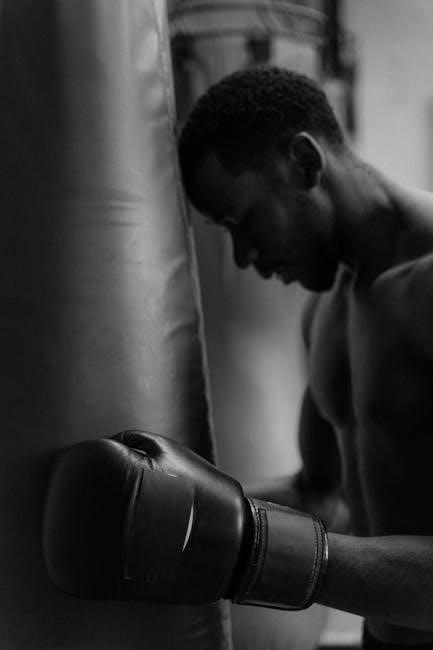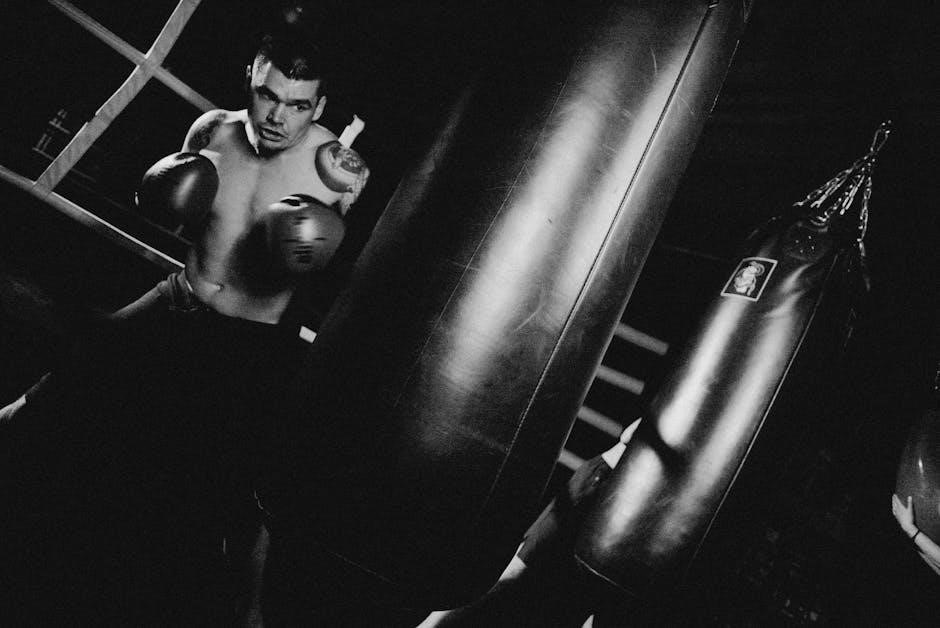
Boxing gloves are essential equipment for boxers‚ providing hand protection and enhancing performance․ Proper sizing is crucial for comfort‚ safety‚ and effectiveness․ Gloves vary in weight and size‚ with measurements based on hand circumference and fighter weight․ A well-fitted pair ensures optimal protection during training‚ sparring‚ and competitions․ This guide will help you navigate the complexities of choosing the right boxing glove size for your needs․
1․1 Importance of Proper Fit
A proper fit in boxing gloves is vital for safety‚ comfort‚ and performance․ Ill-fitting gloves can cause discomfort‚ restrict movement‚ or even lead to injuries․ Properly sized gloves ensure adequate hand protection‚ distribute impact evenly‚ and provide a secure grip․ This is crucial for effective training‚ sparring‚ and competitions․ Selecting the right size prevents joint strain and enhances overall boxing technique and efficiency․
1․2 Brief Overview of Glove Sizes
Boxing gloves come in various sizes‚ typically ranging from 8oz to 16oz or more‚ with sizes catering to different weight categories and uses․ Gloves are sized based on weight‚ hand circumference‚ and intended purpose‚ such as training‚ sparring‚ or competition․ Proper sizing ensures comfort‚ protection‚ and optimal performance‚ making it essential to choose gloves that align with your weight‚ skill level‚ and specific boxing activities․
Understanding Glove Weights
Boxing gloves weigh between 8oz and 16oz‚ with lighter weights for competitions and heavier weights for training․ The weight determines padding and protection levels‚ ensuring safety and performance․
2․1 Common Glove Weights (8oz‚ 10oz‚ 12oz‚ etc․)
Common boxing glove weights include 8oz‚ 10oz‚ 12oz‚ 14oz‚ and 16oz․ These weights cater to different needs: 8oz for youth or light training‚ 10oz for professional fights‚ 12oz for general training‚ 14oz for sparring‚ and 16oz for heavy-duty training․ Each weight offers varying levels of padding‚ ensuring optimal protection and performance based on the boxer’s requirements and activity type․
2․2 Weight and Use Cases (Training‚ Sparring‚ Competition)
Glove weights are tailored for specific activities: 12oz for training and pad work‚ 14oz for sparring‚ and 10oz or 8oz for competitions․ Lighter gloves (8-10oz) are ideal for speed and precision in fights‚ while heavier ones (14-16oz) provide extra padding for sparring and heavy bag training‚ ensuring safety and performance across different boxing disciplines․

Size Charts for Boxing Gloves

Boxing glove size charts correlate hand circumference with glove sizes‚ ensuring proper fit․ They consider weight categories and hand measurements to guide selection accurately․
3․1 Weight Categories and Glove Sizes
Glove sizes are often matched to fighter weight categories‚ ensuring appropriate protection and performance․ For instance‚ lighter boxers (under 141lb) typically use 10oz gloves‚ while heavier boxers opt for 12oz or more․ This alignment ensures that the padding and fit meet the specific demands of each weight class‚ optimizing both safety and comfort during training or competition․
3․2 Hand Circumference Guide for Sizing
Hand circumference is a key factor in determining glove size․ Measure around the knuckles of your dominant hand to find your size․ Small gloves (8-10oz) suit hands under 6․5 inches‚ medium (10-12oz) for 6․5-7․5 inches‚ and large (12-14oz) for over 7․5 inches․ Proper fit ensures protection‚ comfort‚ and mobility‚ avoiding restrictive or overly loose gloves that may hinder performance or cause discomfort during training or competition․

Measuring Hand Circumference
Measure your hand circumference by wrapping a flexible tape around the knuckles of your dominant hand․ This ensures a proper fit and optimal protection during training․

4․1 How to Measure Your Hand Correctly
To measure your hand correctly‚ wrap a flexible tape measure around the widest part of your knuckles‚ excluding the thumb․ Ensure the tape is snug but not tight․ This measurement helps determine your glove size‚ ensuring a proper fit for comfort and protection during training or sparring․ Accurate measurement is key to selecting the right boxing gloves․
4․2 Size Correlation Based on Measurement
Your hand measurement directly correlates with glove size‚ ensuring proper fit and protection․ A smaller circumference typically corresponds to lighter gloves (8-10 oz)‚ while larger hands require heavier gloves (14-16 oz)․ This correlation ensures optimal comfort and performance‚ whether for training or competition․ Accurate sizing enhances protection and prevents injury‚ making it crucial for all boxers․

Types of Boxing Gloves
Boxing gloves come in training‚ sparring‚ and competition styles‚ each designed for specific purposes․ Training gloves are heavier for protection‚ sparring gloves balance padding and mobility‚ and competition gloves are lightweight for performance․ Choosing the right type enhances both performance and safety․
5․1 Training Gloves
Training gloves are designed for daily use‚ offering durability and cushioning for heavy bag work and pad drills․ They typically weigh between 12oz to 16oz‚ providing ample padding to protect hands and wrists during intense workouts․ Their thicker foam ensures comfort and support‚ making them ideal for long training sessions․ Proper sizing is crucial for optimal performance and injury prevention;
5․2 Sparring Gloves
Sparring gloves are designed for partner drills and light contact‚ typically weighing between 14oz to 16oz․ They offer extra padding for increased protection during interactive training․ Proper sizing ensures a snug fit for wrist support and hand mobility․ Sizes often correlate with the fighter’s weight‚ ensuring comfort and safety․ Choosing the right size is crucial for both performance and injury prevention during sparring sessions․
5․3 Competition Gloves
Competition gloves are lightweight‚ typically 8oz to 10oz‚ designed for professional fights․ They provide minimal padding to allow precise punches․ Sizes are chosen based on hand circumference and fighter weight․ Proper fit ensures dexterity and compliance with regulations․ Smaller sizes suit lighter boxers‚ while larger sizes accommodate heavier fighters․ These gloves prioritize performance and meet strict standards for amateur and professional matches․
Skill Level and Glove Size
Amateur boxers often use 10oz gloves‚ while professionals may opt for 8oz or 10oz‚ depending on weight class․ Skill level influences glove size to balance protection and performance․
6․1 Amateur vs․ Professional Boxers
Amateur boxers typically use 10oz gloves to ensure safety during competitions‚ while professionals may use lighter gloves‚ such as 8oz or 10oz‚ depending on their weight class․ Amateur gloves prioritize padding for protection‚ whereas professional gloves are designed for precision and impact absorption․ The skill level and competition rules significantly influence the choice of glove size and weight․
6․2 Choosing the Right Size for Your Skill Level
Beginners should opt for 12-14oz gloves for training and sparring‚ offering ample padding for hand protection․ Intermediate boxers can transition to lighter weights like 10-12oz for improved technique․ Advanced fighters‚ especially professionals‚ prefer 8-10oz gloves for competitions‚ balancing speed and impact․ Skill level determines padding needs‚ ensuring optimal performance and safety in different training and competition scenarios․

Brand-Specific Size Charts
Each brand offers unique sizing charts‚ with variations in glove sizes and weights․ Popular brands like Ego Boxing Gloves provide specific charts for men and women‚ ensuring proper fit․
7․1 Variations Among Different Brands
Different brands offer distinct sizing charts‚ with variations in glove sizes and weights․ For instance‚ Ego Boxing Gloves provide specific charts for men and women‚ ensuring proper fit․ Some brands cater to youth sizes‚ while others focus on professional or heavyweight categories․ These variations emphasize the importance of consulting brand-specific guides to find the perfect fit for your needs․
7․2 Popular Brands and Their Sizing
Popular brands like Ego Boxing Gloves and Hukk offer tailored sizing charts‚ ensuring precise fit․ Ego provides separate charts for men and women‚ while Hukk caters to youth and professional ranges․ These brands emphasize hand circumference and weight categories‚ offering sizes from 6 oz to 16 oz․ Their sizing systems ensure optimal comfort and protection‚ making them favorites among boxers of all levels․

Common Mistakes in Choosing Glove Size
Common mistakes include oversizing or undersizing gloves‚ which can hinder performance and safety․ Ignoring hand measurements often leads to poor fit and discomfort during training or sparring․
8․1 Oversizing or Undersizing
Oversizing or undersizing boxing gloves is a common mistake․ Oversized gloves can feel bulky‚ reducing control and precision․ Undersized gloves may restrict hand movement‚ causing discomfort and increasing injury risk․ Proper fit ensures optimal performance‚ safety‚ and comfort during training or competition․ Always refer to size charts and hand measurements to avoid these issues and select the right glove for your needs․
8․2 Ignoring Hand Measurement
Ignoring hand measurement is a critical error when selecting boxing gloves․ Proper sizing requires measuring hand circumference to ensure a snug‚ comfortable fit․ Without accurate measurements‚ gloves may be too tight or too loose‚ leading to poor performance and increased injury risk․ Always use a tape measure to determine your hand size and refer to size charts for the best fit;
Choosing the right boxing glove size is crucial for both safety and performance․ Proper fit ensures comfort and effectiveness‚ making it essential to measure hand circumference and consider weight categories․ Always refer to size charts for accurate selection to enhance your training and competition experience․
9․1 Summary of Key Points
Properly fitting boxing gloves are vital for safety and performance․ Measure hand circumference and consider weight categories to select the right size․ Gloves range from 8oz to 16oz‚ with lighter weights for smaller hands and heavier weights for larger hands or sparring․ Refer to size charts for accurate fitting‚ ensuring comfort and protection during training or competition․ Correct sizing prevents injuries and enhances your boxing experience․
9․2 Final Tips for Choosing the Right Size
Always try gloves on if possible‚ as fit can vary between brands․ Ensure your thumb sits comfortably in the thumb compartment for proper alignment․ Opt for gloves with adequate padding to protect your hands during impact․ Consider your training purpose—lighter gloves for speed drills and heavier for sparring․ Prioritize comfort and protection to enhance your boxing performance and safety․

Further Reading and Resources
Explore detailed guides‚ size charts‚ and expert recommendations online for a deeper understanding of boxing glove sizing․ Visit reputable sports websites or manufacturer resources for additional insights․
10․1 Additional Resources for Glove Sizing
For further guidance‚ visit official manufacturer websites like Everlast or Title for detailed size charts․ Check out the Boxing Glove Size Guide or MMA Gear Planet for comprehensive sizing tips․ Reputable brands often provide specific sizing resources‚ while forums like Reddit’s r/boxing offer community-driven advice․ These resources ensure you find the perfect fit tailored to your needs․

10․2 Recommended Reading for Boxing Enthusiasts
Explore articles on Boxing Gloves 101 and The Ultimate Guide to Boxing Gear for in-depth insights․ Websites like ExpertBoxing and BoxingNews24 offer detailed glove sizing guides․ For hands-on advice‚ check out forums like Reddit’s r/boxing‚ where enthusiasts share their experiences․ Additionally‚ consider books like The Art of Boxing for a comprehensive understanding of equipment and training․